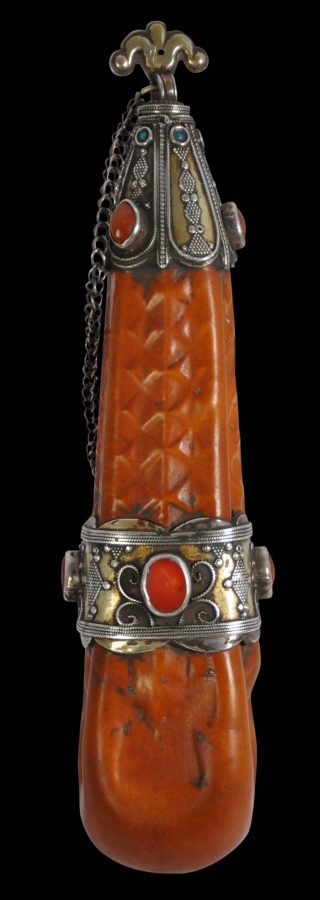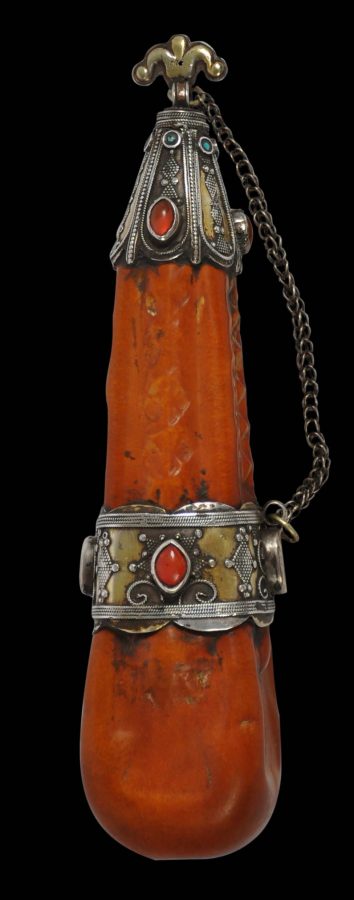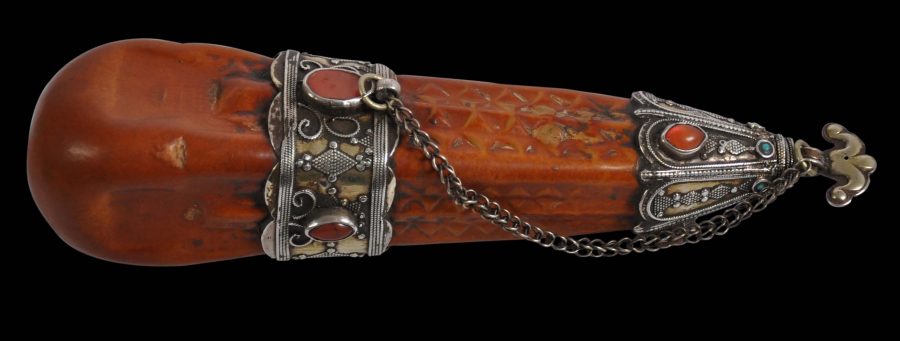This rare, superb container, made of a dried, hollowed gourd, was made to hold a type of snuff tobacco that was used not for snorting so much as chewing, and would be kept by the male owner tucked into his belt. The tobacco would be ground to a fine, green powder and was sometimes mixed with powdered charcoal and shredded, dried fat. A quantity would be placed behind the lower teeth under the tongue.
The squarish shape of the gourd with its flattened sides marked with ribs and zig-zag motifs was achieved by growing it in a mould. It is the best-moulded gourd that we have seen used in this way. (See Fihl, 2010, p. 502 for two other examples.)
It is decorated with fire-gilded silver mounts that are themselves decorated with silver wire and granulation work and inset with large, lozenge-shaped carnelian or agate stones and small turquoise cabochons.
A long stopper that sits inside the gourd and which pulls out is attached to a fine silver chain which in turn is attached to the side of the gourd. The stopper is topped with a fabulous, gilded terminal which Kalter (1984, p. 101) identifies as based on a stylised set of ram’s horns.
Samarkand was one production centre for these gourd containers (where they were known as a noschadu) and from here they were exported to elsewhere in the region.
Such gourd containers were used by the Uzbek, Tekke, Afghan and related peoples.
The area was part of the ‘Silk Road’, the series of trade routes that spread from China to Europe, and so was subject to significant Chinese influence. It is possible, that the preference for these gourds, with their ‘double gourd’ shape was a consequence of Chinese influence from trade. In China, the gourd is known as hulu (葫芦). The first character hu (葫) is a homophone for the word that means ‘to guard or protect’ (hu 护) and also the word for ‘blessing’ (hu 祜). Gourds have many seeds and so they are also associated with fertility and having many sons. Additionally, the shape is reminiscent of the number 8, which in Cantonese at least is pronounced as fatt (发) – a homonym for wealth and to prosper.
The example here is in excellent condition and has a superb glowing patina from use, age and handling. It is a museum-quality example.
References
Fihl, E., Exploring Central Asia, Volume 2, University of Washington Press, 2010.
Hoek, C., et al, Ethnic Jewellery: From Africa, Asia and Pacific Islands, Pepin Press, 2004.
Kalter, J. (ed.), Uzbekistan: Heirs to the Silk Road, Thames & Hudson, 1997.
Kalter, J., The Arts and Crafts of Turkestan, Thames & Hudson, 1984.







